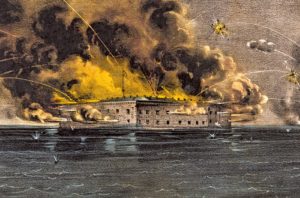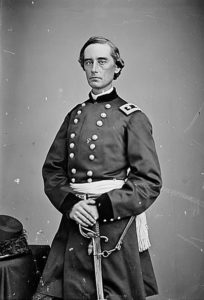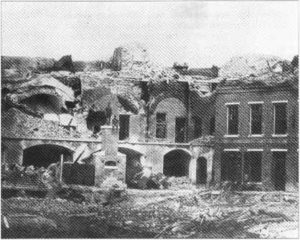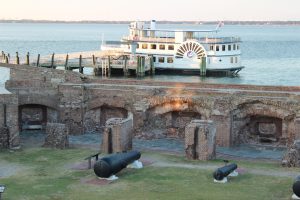This week’s blog will explore the bombing on Fort Sumter. 160 years ago, on April 12, this event marked the beginning of the American Civil War. With the booming of cannons over the harbor in Charleston, South Carolina, the crisis of the Southern states seceding that held America captive for months abruptly escalated into a shooting war. The attack on the fort was the culmination of a simmering conflict in which a small garrison of Union troops in South Carolina found themselves isolated when the state seceded from the Union. The action at Fort Sumter lasted less than two days and had no strategic significance. And casualties were minor. But the symbolism was enormous on both sides. Once Fort Sumter was fired upon there was no turning back. The North and the South were at war.

Contributed: Currier & Ives/Library of Congress, Washington, D.C.
Fort Sumter was built after the War of 1812 to protect the city of Charleston from foreign invasion, and it was designed to repel a naval attack coming from the sea, not a bombardment from the city itself. But Major Anderson felt it was the safest place in which to place his command, which numbered less than 150 men. The secessionists of South Carolina were outraged by Anderson’s move to Fort Sumter and demanded that he vacate the fort. Demands that all federal troops leave South Carolina intensified and the anger was turned towards the men in Fort Sumpter. Obviously, Major Anderson and his men couldn’t hold out for long at Fort Sumter with no food or supplies, so the Buchanan (Lincoln had not been inaugurated yet) administration sent a merchant ship to Charleston to bring provisions to the fort. The ship, Star of the West, was fired on by Confederate batteries on the shore, and failed to reach the fort.

Major Robert Anderson
Contributed: National Archives and Records Administration
When Lincoln took over office in March, he was made aware of the situation in South Carolina. He promptly ordered the US Navy to take supplies down to Anderson and his men. The new Confederate government continued to demand that they vacate the Fort and leave. When Anderson still refused, they began firing on Fort Sumter early on the morning of April 12, 1861.
The Confederates cannon fire surrounding Fort Sumter went unanswered until after daylight, when Union gunners began returning fire. Both sides exchanged cannon fire throughout the day of April 12, 1861. By nightfall, the shooting slowed, and a heavy rain poured down on the harbor. In the clear of the morning, the cannons roared again, and fires began to break out all around the fort. Now with no protection and the fort in ruins, and with supplies running out, Major Anderson was forced to surrender.

The interior of Fort Sumter photographed in September 1863. The hot-shot furnace appears undamaged, but the northeastern casemate wall and the casemate wall above it have suffered extensive damage.
Contributed: Clyde Hensley Collection
The surrender terms required the Union troops at Fort Sumter pack up and sail to a northern port. On the afternoon of April 13, Major Anderson ordered a white flag to be raised over Fort Sumter. No one died during the attack on Fort Sumter, however two Union troops died during a freak accident at a ceremony after the surrender when a cannon misfired.
People up North were outraged by the attack on Fort Sumter. On April 20, 1861, Major Anderson was part of a gigantic rally in New York City, even waved the flag that had flown over the fort. The New York Times estimated the crowd at more than 100,000 people. He also toured the northern states, recruiting troops to fight against “the rebels” down South. Northern newspapers published stories about men joining up to fight the rebels and regiments of soldiers heading southward. The attack on the fort had produced a patriotic wave and united the Union. In the South, feelings also ran high. Parties were thrown celebrating the secession and southern men were also eager to sign up to fight for their beliefs. The men who fired the cannons at Fort Sumter were heroes, and the new Confederate government began to form an army and plan for war.
The “battle” at Fort Sumter was not anything huge in a military sense. However, the symbolism of it was enormous. Intense feelings over the incident in Charleston propelled the nation into war. And, of course, no one at the time had any idea the war would last for four long and bloody years. Or the permanent effects it would have on our country almost 200 years later. Today Fort Sumter is a preserved national monument, you can still visit it and see the site where the Civil War started.

Modern Day Fort Sumter





